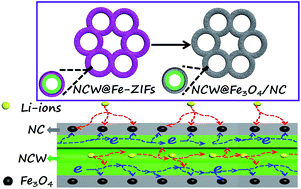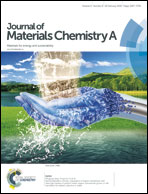Ultrasmall Fe3O4 nanodots within N-doped carbon frameworks from MOFs uniformly anchored on carbon nanowebs for boosting Li-ion storage†
Abstract
Metal–organic frameworks (MOFs) have attracted great attention for energy storage and conversion applications due to their highly porous structure and tunable chemical composition that can be designed at the molecular level. Accordingly, it becomes highly urgent to develop novel strategies for fabricating MOFs or MOF-derived functional materials. Utilizing the self-assembly of Fe-based MOFs, [Fe(MeIm)2]n (MeIm = 2-methylimidazolate) on N-doped carbon nanowebs (NCWs), a well-defined 3D hierarchical architecture with ultrasmall Fe3O4 nanodots embedded within an N-doped carbon (NC) framework is obtained in this work. Remarkably, this self-assembly process is also applicable to other types of MOFs, such as [Co(MeIm)2]n and ([Ni(MeIm)2]n), and other types of carbon substrates, such as 1D carbon nanotubes and 2D graphene. Benefiting from the unique structural advantages of the materials prepared through such a MOF-engaged method, the as-prepared 3D structured NCW@Fe3O4/NC composite exhibits outstanding reversible capacity, excellent rate behavior (723 mA h g−1 at 10 A g−1), and good cycling performance (1741 mA h g−1 after 600 cycles at 1000 mA g−1) as the anode material of Li-ion batteries.



 Please wait while we load your content...
Please wait while we load your content...